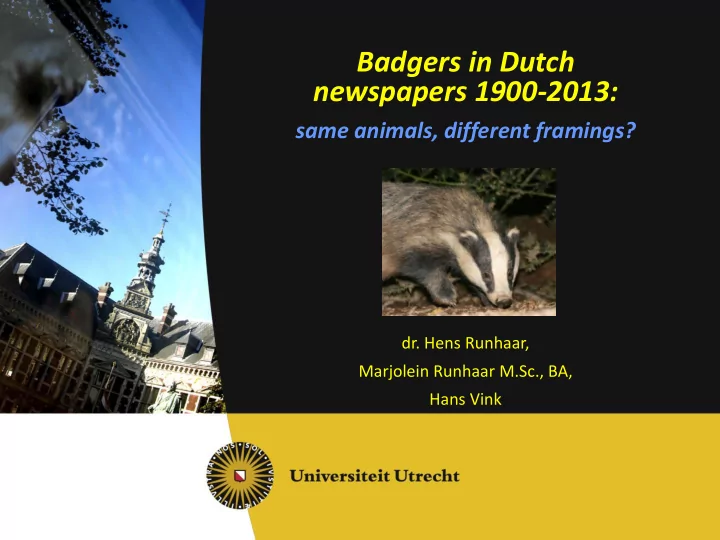

Badgers in Dutch newspapers 1900-2013: same animals, different framings? dr. Hens Runhaar, Marjolein Runhaar M.Sc., BA, Hans Vink
Contents 1. Background and objectives 2. Analytical framework 3. Method 4. First results 5. Preliminary conclusions
1. Background • Badgers in the UK: very controversial: • Badgers as ‘reservoirs’ of bTB • Culling of badgers to reduce bTB among cattle • Controversy since the 1970s
• Cassidy (2012): controversy explained by two opposing badger framings: • ‘Good badger’: strong, brave, aesthetically pleasing animals that symbolise the typical English countryside • ‘Bad badger’: behaviours that bring them into conflict with humans (digging, damage to crops, violent behaviour etc.) • Framings have historical roots • bTB debate triggered their manifestation, perhaps intensified framings, but did not create them
• Badgers in the Netherlands: • Population at risk in 1960 due to prosecution; despite more protection another 30% reduction until 1980 • Since the 1980s gradual recovery and since 2000, substantial increase • NL: no bTB, but other confrontations with humans • Overall attitude and behaviour towards badgers nowadays seems positive (literature, newspapers) • Poaching, digging, and baiting seldom reported anymore • Active protection against ‘new’ threats (road kill)
Objectives • Questions that emerged • Are badger framings in NL different from those in UK? • Have badger framings in NL changed over time? • Have framings of different actor categories changed over time? • What explains differences/changes? • What influences do badger framings have on how people behave towards badgers? • Aims • Explore badger framings and how they change over time, and explore the social consequences
2. Analytical framework • Framings (or frames) • Selection devices with which people interpret and give meaning to particular phenomena • Origin in various disciplines, many approaches • Usually presented as concepts or storylines, that reflect the most salient aspects of the subject at issue • What is framed? • Subtopics/aspects • Tone • Placement (situation, actor involved)
• Framings in Cassidy’s (2012) paper • Not so much badgers in themselves, but more about badgers in relation to humans • Placement: bTB , other situations? (farming, traffic, …) • Actors • Tone (positive, neutral, negative) • Explaining framings • Human-wildlife literature: framings influenced by information, gender, age, location (familiarity), personal experiences • Consequences of framings • ‘Good badger’ protect, ban on culling • ‘Bad badger’ vermin, cull, manage, control • Irreconcilable framings controversy and deadlock
6. Method • Steps: • Identification of framings • Exploring the consequences of framings • Explaining (changes in) framings • Step 1-2: newspaper article analysis • Newspaper articles 1900-2014 • 1900-1990: personal archive Hans Vink • 1980-2014: LexisNexis • More or less complete since the 1980s (we think)
6. Method • Newspaper articles: - Potentially biased - May influence framings rather than neutrally presenting these + Allow for systematic, replicable, comparable and longitudinal data collection ‘Check’ by literature and personal experiences Hans Vink (additional interviews needed?)
6. Method • Step 3: explanations: • Literature (in part ‘grey’) • Personal experiences Hans Vink (backed up with examples if possible)
6. Method • Coding newspaper articles (1,184 articles; 1,478 frames) • Consistency in coding important • Two researchers • Iterative development of coding book • Eventual inter-rater reliability Situation Actor Aspect Claim % 79% 91% 74% 79% Kappa .745 .819 .668 .699
6. Method • Coding book
7. Results • Newspapers do no show radical changes in badger framings over time, but: • Since 1980s (we need to cluster older articles differently) • Overall picture (biased by dominance Das en Boom)
Framings of nature conservationists
Framings of public actors • Changes over time: • More often negative • Badgers hindering spatial developments or protection too expensive? • Have to check notes
Framings of farmers • Big difference with conservationists • But small n • Direct contact with (negative aspects of) badgers
Framings of farmers
Aspects focused on, in general • Aspect that is focussed on, changes over time: • Mostly about ‘damage done to badgers’ • Incidents versus structural damage (A73) • Increasingly about recovery of badger population
Claims (what is/should be done?) 100% 90% 80% 70% 60% 50% 40% 30% 20% 10% 0% s s s r s s s r n e r r t e e e e e h s i w p h t i z t n i c i O e r o t o a o e i C r o i h g k t P a t e , u v s m a r r e e a c s m g i n l b r o , a s u c r F P e e t r n u u t a H N Kill, catch Remove, replace Protect Compensate Raise interest Convict (morally) No/unclear
1918 Claims and framings from the past? 1949
8. Preliminary conclusions • The two framings comparable to UK • NB: large part of the NL population probably has no framing of badgers at all • Less barbarian framings/behaviour, why? • Extra laws and Das en Boom as a watchdog • Civilisation? • Urbanisation/distance? • Current trend: badgers ‘urbanise’ • Our impression: mixed picture, but not often welcome • Placement seems to matter for framings!
End • Thanks for your attention! • Questions? Hints? • See www.dassenwerkgroeputrecht.nl for our work
4. Badgers in NL: a brief introduction • About 5,000 now • 1,200 in 1960, 400 setts in 1980 • Hunting, digging, and baiting until 1960s • Traffic and habitat loss since 1980s • Legal protection since 1947 (setts 2003) • 1981: foundation of Das en Boom
Recommend
More recommend